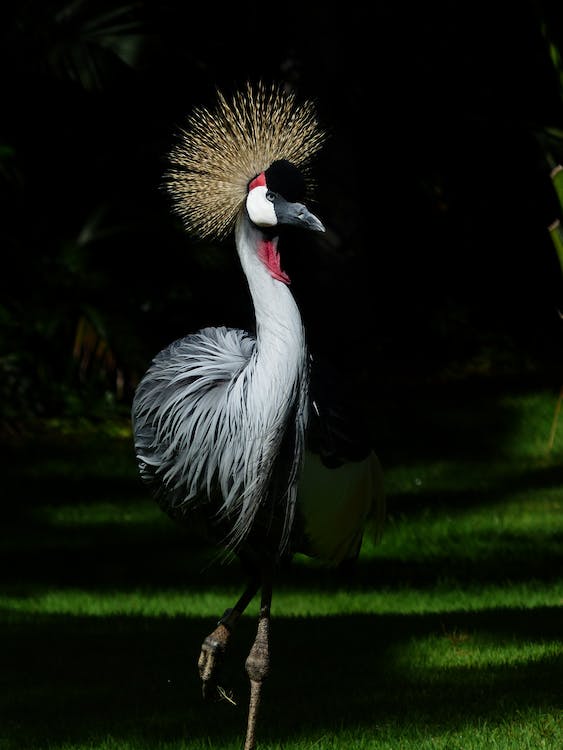It is a majestic, blue-gray crane, with a black-and-white face, renowned for its golden-yellow crown. Prefers flooded grasslands, wetlands, and other various water bodies and open habitats, occurring in singles, pairs, or small flocks. Mainly resident but may do necessary movements within its range following the rains. Groups quickly attract attention with their deep, wistful, honking calls.
Read further to know more about the Grey Crowned Crane.
What is a Grey Crowned Crane?
Grey Crowned Crane (Balearica regulorum), also called as the golden-crowned crane, golden crested crane, East African crane, African crowned crane, is bird species belonging to the family Gruidae. It is one of Africa’s most striking and beautiful birds and is the national symbol and bird of Uganda. Its name was derived from its distinct golden-yellow crown of feathers, with black tips. The species can be found in eastern and southern Africa.
Its seven levels of classification are as follows:
Kingdom: Animalia
Phylum: Chordata
Class: Aves
Order: Gruiformes
Family: Gruidae
Genus: Balearica
Species: B. regulorum
Grey Crowned Crane Physical Description
Grey Crowned Crane is a medium-to-large bird, growing around 3.3 feet tall or 1 meter, weighing about 3 to 4 kilograms, with a wingspan of 6.5 feet or 2 meters. Its plumage is mostly gray, while its wings sport a white band with yellow streaks. Neck feathers are relatively lighter than the rest of the body. Meanwhile, the bottom of the cheeks has a white patch, red on top while the rest of the face is black. The bird’s name was derived from its conspicuous golden-yellow crown feathers, with black edgings. The bill is short with a gray tone. Legs are long and gray, equipped with long hind toes that enable them to perch on trees. A red gular sack, which may inflate, is located at the bottom of its chin. Juveniles are generally grey with a brown nape and crown, reaching adult plumage after a year.
Where can they be spotted?
Grey Crowned Cranes thrive in eastern and southern Africa, from Kenya to Uganda, Zimbabwe and South Africa. These birds prefer savannas, wetlands, open grasslands, marshes, and cultivated lands. They can also be found in modified areas, such as flooded locations, croplands, and pastures.
Interesting Facts You Should Know About the Grey Crowned Crane
Grey Crowned Cranes are omnivorous, feeding on plant matters, such as seeds, and fresh grass parts, and insects, such as locusts, crickets, grasshoppers, and frogs, lizards, crabs, and worms. As it forages, it pecks rapidly and may stomp its feet to disturb invertebrates or uproot certain plants. They can also be observed following grazing animals that derange prey items from the ground. These birds are not known for defending their foraging areas.
Outside the breeding, Grey Crowned Cranes are pretty gregarious, roosting together in water or trees, composed of 30 to 150 individuals. Their long hind toes, allow them to perch on tree branches.
During the breeding period, these cranes perform spectacular courtship displays, such as dancing, running, jumping, and bowing. These acts are accompanied by deep, loud calls, while their head is stooped down the shoulder level. Inflation of their red gular sacs can also be observed.
These birds are monogamous and will form lifelong bonds with their partner, often seen preening each other or dancing together even outside the breeding period. Copulations usually occur numerous times before the egg-laying season. The pair picks the nesting site and will make calls to declare their territory. Both sexes also construct the nest, situated on wetland edges, concealed in thick aquatic vegetation. Rarely, they may build nests on trees or reuse abandoned ones.
The female Grey Crowned Crane will lay a clutch consisting of 1-4 eggs. Both parents incubate the eggs for about 50-60 days. Soon, broods will fledge at around 56 to 100 days of age. The juveniles will join the flock and reach sexual maturity after three years.
Grey Crowned Crane’s population is declining due to habitat loss, drought, loss of breeding locations to drainage of wetlands and overgrazing. Their number is also affected by hunting, egg collecting, and pet trade. Use of pesticides is also a culprit as it kills the insects these cranes eat. Overall, the bird species is currently evaluated as Endangered (EN) under the IUCN Red List of Threatened Species.
WILDLIFE PARKS AND RESERVES WHERE THIS SPECIES IS FOUND:
BOTSWANA
SOUTH AFRICA
NAMIBIA
ZAMBIA
ZIMBABWE
BOTSWANA BIRDS | SOUTH AFRICA BIRDS
NAMIBIA BIRDS | ZAMBIA BIRDS | ZIMBABWE BIRDS

